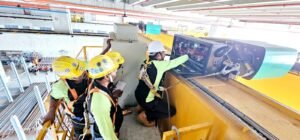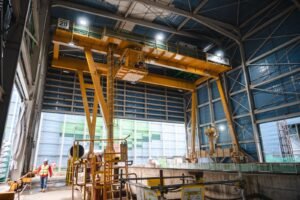Jenmon | Blogs
What to Expect During an Overhead Crane Inspections
Your operations are dependent on your overhead crane as you operate it daily. But why and how are proper crane inspections done? Routine checks ensure the safety of your equipment, avert expensive repairs, and see to it that you are operating within the safety requirements in Singapore. This guide encourages you to get to know the part of the crane inspection and how to carry it out, with the reasons behind such inspection, as well as what the inspectors really examine.
Why Overhead Crane Inspections Matter
Inspections of overhead cranes eliminate equipment failure ahead of time. Planning periodical checks will ensure not just excellent productivity but also compliance with safety regulations. Check your cranes to ensure that you have met Workplace Safety and Health regulations in Singapore. Such inspections help to minimise the risks associated with accidents and unexpected downtimes, which cost your business money. Smart operators just understand that prevention is always better than correction.
Types of Inspections Required for Overhead Cranes
You should have two major categories of inspections on your overhead cranes: these are frequent and periodic inspections. Any checks that are carried out regularly may be visual, daily checks, and operating checks. Periodical checks are done monthly, quarterly, and yearly, depending on the operations of your cranes. Cranes in management under regular service must have specific inspection schedules as required by the Workplace Safety and Health Act. Your inspection frequency depends on how heavily you use your equipment.
The Crane Inspection Process
All the mechanical parts, including the hoist chains, runway systems, and operating mechanisms, are inspected. The inspectors are the ones who perform regular checks of important components of your overhead crane system, which usually happen daily or monthly. These checks detect traces of wear and tear in time before the damage is apparent. Inspections of visual and safety aids will identify problems that may result in poor performance of your crane. Checks ought to be organised properly, with checklists.
What’s on a Typical Overhead Crane Inspection Checklist
The crane inspection checklist covers all the important parts of this crane that are required to be monitored regularly. The inspectors ensure that your overhead cranes and hoists, and lifting equipment are in line with the compliance requirements. Checklist items help maintain regulatory compliance whilst supporting preventative maintenance programmes. The inspection identifies potential problems and creates data for planning future repairs or maintenance. This systematic approach keeps your hoist chains and equipment in top condition.
How Often Should Overhead Crane Inspections Be Done?
Inspection frequency depends on your crane usage and the environmental conditions where you operate. HSE recommendations provide clear guidelines for different types of crane operations. Heavy crane usage requires more frequent inspections than occasional use of equipment. Annual inspections become mandatory for cranes in regular service regardless of usage levels. You must consider both regulatory requirements and practical needs when scheduling inspections.
What Happens if You Skip Crane Inspections?
Skipping inspections creates serious safety risks and increases the chances of equipment malfunction. Non-compliant operations affect your crane operation efficiency and put workers at risk. You face potential downtime and expensive repair costs when problems go undetected. Poor maintenance threatens occupational safety and health standards in your workplace. Industry best practices show that regular inspection data prevents most operating mechanism failures.
Jenmon’s Preventive Maintenance and Inspections
We schedule routine maintenance works and check-ups that help you save considerable time, resources, and money. As Singapore’s market leader, we understand how prevention programmes ensure smooth, continuous operations throughout your crane’s lifetime. Our routine maintenance prolongs your equipment’s lifespan whilst reducing critical downtime and preventing compliance violations. We help detect defects quickly, schedule convenient follow-up repairs, and plan safe shutdowns that won’t disrupt your production.
How Routine Crane Maintenance from Jenmon Can Benefit You:
- Keep your equipment in its optimum working condition
- Prolong your equipment’s life span
- Help your company plan ahead for a safe shutdown that will not affect your production
- Lower your maintenance costs
- Reduce unanticipated breakdowns and maintain smooth production
- Defects can be detected and resolved quickly
- Decrease the risk of injuries and property damage due to equipment failures
- Personnel will be able to focus on their main tasks at hand
- Follow-up repairs can be scheduled at your convenience
Final Thoughts: Staying Compliant and Safe with Regular Inspections
A structured inspection and maintenance programme benefits your entire operation significantly. Regular inspections support crane longevity and maintain high productivity levels throughout your facility. You need to focus on the safety standards and ensure that you comply with the Singapore Occupational Safety and Health Division requirements. Smart companies promote frequent check-ups and professional analysis to avoid issues prior to them developing. The investment in preventive maintenance ensures the asset’s safety and efficacy.




